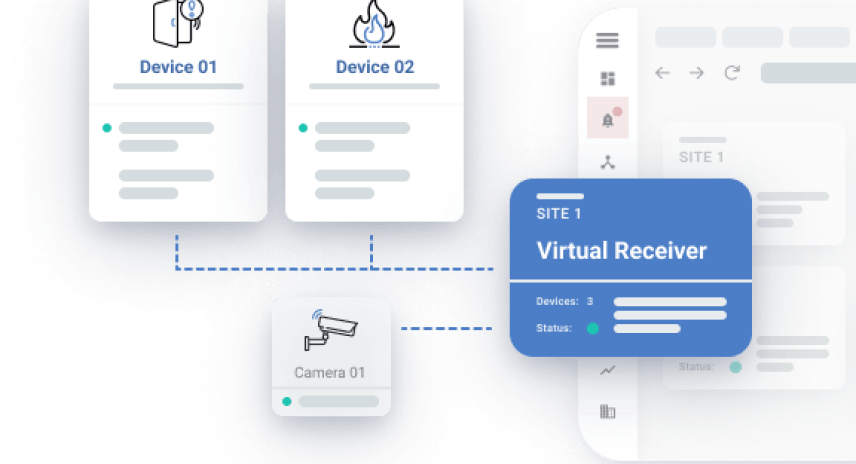
- Smart Alarm Management
How alarm monitoring centers grow future-proof with virtual receivers
Alarm monitoring centers protect businesses and organizations from potential security threats. Therefore, running efficient security operations is crucial for operators – only this will allow them to respond quickly and effectively to incoming alarms that indicate security incidents.
However, traditional on-premise systems are slowly becoming outdated, and analog receivers are reaching their end-of-life due to advances in digital technology. Because they may lack the capabilities and flexibility needed for seamless integration and efficient operation, legacy analog infrastructures and equipment are a barrier to alarm monitoring center efficiency. That's why many control centers are looking for an alternative.
By migrating their alarms to a virtual infrastructure, alarm monitoring centers can move away from on-premise receivers to a more flexible, scalable, and easy-to-update solution that can handle large volumes of alarms and allow them to remain competitive.
Are you curious how moving to a virtual infrastructure can help you future-proof the alarm management system in your alarm monitoring center? Then, let's dive in!

What is a virtual receiver?
A virtual receiver is a virtual representation of a physical alarm receiver typically used in security systems. It's a software- and cloud-based component or module that acts as a central hub for alarm monitoring centers to receive and process alarms and events from various sources, such as intrusion detection systems, fire alarms, and environmental sensors. Virtual receivers work with multiple alarm or fire panel protocols, including audio and video, and integrate with existing alarm monitoring systems.

Virtual receivers perform several key functions:
- Alarm Reception: Virtual receivers receive alarm signals and events from various sources, including physical alarm panels, remote sensors, surveillance cameras, and other connected devices. These signals are typically transmitted via the most common protocols or proprietary interfaces.
- Protocol Translation: Virtual receivers can translate incoming alarm signals from different protocols into a standardized format that the alarm management platform understands. This allows the platform to effectively process and manage alarms from diverse sources.
- Alarm Processing: Once a virtual receiver receives an alarm signal, it performs initial processing tasks such as validation, filtering, and categorization. It checks the received alarms for authenticity, correctness, and consistency before forwarding them to the appropriate components within the alarm management platform. That way, virtual receivers can help you rule out false alarms at an early stage.
- Event Distribution: Virtual receivers distribute the processed alarms and events to the relevant parts of the alarm management platform. They ensure that alarms reach the appropriate users or subsystems for further analysis, response, and action.
- Integration: Virtual receivers often have built-in integration capabilities to connect with other systems and services. They can interface with incident management systems, dispatch systems, reporting tools, and other software components to facilitate seamless coordination and communication.
The benefits of virtual alarm transmission for alarm monitoring centers
Modern alarm management platforms alone offer several benefits, including a unified view of security and monitoring infrastructure, streamlined alarm processing, and improved situational awareness for better incident response. Integrating a virtual receiver adds even more benefits on top:
- Cost-Effectiveness: Unlike physical alarm receivers that require dedicated hardware, virtual receivers are software-based components. Since they run on a server, they eliminate the need for rack-mounted hardware receivers. This reduces maintenance, training costs, space, and power requirements, making additional hardware investments unnecessary – the results: Optimized resource allocation, streamlined operations, and increased flexibility in deployment.
- Data and Analytics: Virtual receivers capture and analyze a wealth of data incoming from various security devices. This real-time data can be utilized to gain insights into security patterns, trends, and anomalies, leading to better decision-making and proactive security measures for monitoring stations.

- Protocol Flexibility: Virtual receivers can receive different protocols from alarm or fire panels, including audio files and video streams, and translate them into a standardized format. Harmonizing various systems and technologies enables alarm monitoring centers to process alarms from diverse sources. The resulting flexibility allows the alarm management platform to support a wide range of devices and protocols, facilitating the integration of new systems and the expansion of monitoring capabilities as needed. That way, alarm monitoring centers can offer their customers a more comprehensive range of services and serve clients with specialized needs.
- Integration and Collaboration: Virtual receivers can seamlessly integrate with other systems and services, such as incident management systems, video surveillance, access control systems, and reporting tools. This integration improves collaboration and coordination across departments or stakeholders involved in incident response, enhancing overall security operations. They can also easily integrate with alarm monitoring centers' existing systems, making it easier for them to adopt virtual infrastructure without disrupting their operations.
- Remote Monitoring and Management: Virtual receivers can be accessed and managed remotely over IP networks, allowing alarm monitoring centers to provide uninterrupted client services. This is particularly important in today's increasingly connected world, where customers expect 24/7 access to alarm monitoring services.
- Scalability: Virtual receivers offer upward and downward scalability depending on the changing needs of the alarm monitoring center. This allows them to manage a growing number of alarms and devices and quickly and easily expand their services to meet their customers' needs – without worrying about the cost of upgrading their physical infrastructure. As new sensors or systems are added to the infrastructure, they can adapt and accommodate them. This ensures that the alarm management platform remains up-to-date and meets evolving security requirements.

Growing future-proof with evalink cloud-based virtual receivers
By migrating their infrastructure to a digital system, alarm monitoring centers can work towards a future-proof alarm management system and stay ahead of the evolving security landscape. They can offer their clients more comprehensive and efficient security services and run fit-for-future operations. evalink virtual receivers transmit alarms to an alarm management platform that is truly native cloud-based. Acting as a bridge between analog and digital, they easily fit into alarm monitoring centers' existing operations.



